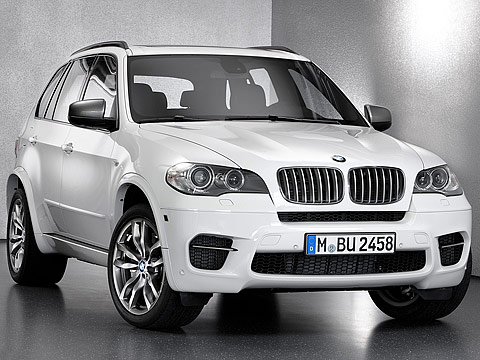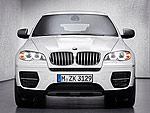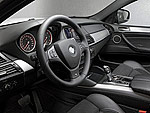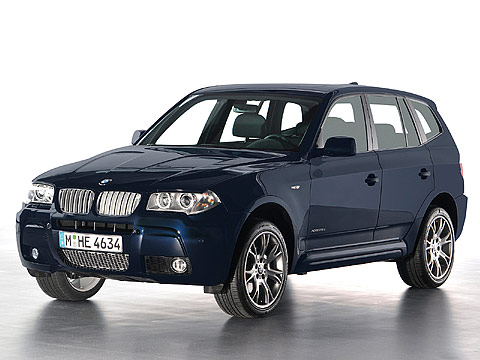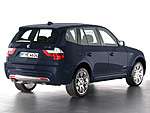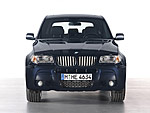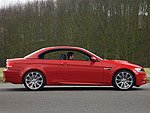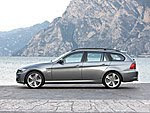Gambar Mobil BMW:
2013 BMW X6 M50d
M Performance TwinPower Turbo technology: an efficient route to enhanced sporting performance.
The launch of the BMW M Performance Automobiles adds another layer to the BMW X models' reputation for presence, poise and efficiency. With the most powerful diesel in the BMW engine line-up and the optimisation of power transfer, handling and aerodynamic balance for which M is renowned, the BMW X5 M50d and BMW X6 M50d set new standards in their class in terms of sporting performance, conceptual harmony and efficiency.
The global success of the BMW X model concept is rooted in a level of sporting flair unmatched by any other all-wheel-drive car with off-road capability. The powerful engines, advanced chassis technology and BMW xDrive all-wheel-drive system (whose primary talent, in addition to maximising directional stability and traction on loose ground and in adverse weather conditions, lies in enhancing dynamic performance through corners) of the BMW X5 and BMW X6 provide driving pleasure beyond the reach of their segment rivals. Plus, the six-cylinder in-line diesel versions of the Sports Activity Vehicle and Sports Activity Coupe, in particular, impress with surprisingly low fuel consumption and emissions given their construction and performance capability.
Increased diesel power and an M-specific set-up make the BMW X5 M50d and BMW X6 M50d even more assured performers. The engine developed for the BMW M Performance Automobiles generates maximum output of 280 kW/381 hp and peak torque of 740 Newton metres (546 lb-ft), making the two BMW X models the envy of every other diesel-engined model in this segment. The BMW X5 M50d races from 0 to 100 km/h (62 mph) in 5.4 seconds, while the BMW X6 M50d brings that time down to 5.3 seconds. Both models also benefit from the immense reserves of power provided by their diesel engine when it comes to short sprints at higher speeds. Top speed is electronically limited to 250 km/h (155 mph) in both cases.
 The two models' frugal approach to fuel use offers further evidence of
their impressive abilities. At 7.5 litres per 100 kilometres (37.7 mpg
imp) and 7.7 l/100 km (36.7 mpg imp) respectively in the EU test cycle,
the average fuel consumption figures of the BMW X5 M50d and BMW X6 M50d
are only slightly above those for the existing diesel variants of the
two models. CO2 emissions stand at 199 grams per kilometre for the BMW
X5 M50d and 204 grams per kilometre for the BMW X6 M50d.
The two models' frugal approach to fuel use offers further evidence of
their impressive abilities. At 7.5 litres per 100 kilometres (37.7 mpg
imp) and 7.7 l/100 km (36.7 mpg imp) respectively in the EU test cycle,
the average fuel consumption figures of the BMW X5 M50d and BMW X6 M50d
are only slightly above those for the existing diesel variants of the
two models. CO2 emissions stand at 199 grams per kilometre for the BMW
X5 M50d and 204 grams per kilometre for the BMW X6 M50d.Outstanding efficiency is a characteristic the eight-speed Sports automatic transmission in the BMW X5 M50d and BMW X6 M50d shares with the new diesel engine. Added to which, BMW EfficientDynamics technology guarantees intelligent energy management. Brake Energy Regeneration, the need-based operation of ancillary components and a disengageable air conditioning compressor are all standard.
BMW xDrive: intelligent control, optimised to enhance dynamics.
The BMW xDrive all-wheel-drive system uses an electronically controlled multi-plate clutch to distribute the engine's power between the front and rear wheels variably and according to the situation at hand. Indeed, drive can be switched between wheels in a split-second to optimise traction, directional stability and driving dynamics. xDrive and the DSC stability control system work together to provide advance analysis of the driving situation ahead. The ability to detect the danger of drive slip at an early stage and counteract one or several spinning wheels by varying the distribution of power has helped earn xDrive its status as an intelligent all-wheel-drive system.
In normal driving situations drive is sent predominantly to the rear wheels, accentuating the renowned handling characteristics of BMW cars. The M-specific set-up of the BMW X5 M50d and BMW X6 M50d has been optimised to enhance dynamics, helping it to retain a rear-wheel bias under dynamic cornering. Even when the car is stable through corners, a larger proportion of the engine's power is channelled to the rear axle to enhance agility and stave off understeer.
In addition, Performance Control enhances the handling agility of the BMW X5 M50d, while Dynamic Performance Control does a similar job for the BMW X6 M50d. As soon as the front wheels of the BMW X5 M50d start to push excessively to the outside of a corner, the control electronics of xDrive and DSC team up to brake the rear wheel on the inside of the bend as required. The loss of forward propulsion is balanced out by an increase in engine power, the intervention of Performance Control ensuring precise turn-in. Power distribution can be varied to an even greater degree in the BMW X6 M50d, which comes as standard with Dynamic Performance Control. This system reroutes engine output from the inside rear wheel to the outside rear wheel around a corner if the system detects an imminent risk of understeer. Dynamic Performance Control also counteracts oversteer in its early stages, switching drive from the outside rear wheel - which is experiencing particularly high centrifugal forces - to the inside rear wheel. Dynamic Performance Control also steps in to stabilise the car when the driver takes his foot off the accelerator, ensuring precise and agile turn-in and enabling extremely dynamic acceleration out of corners.
M-specification chassis set-up produces accurate steering and precisely controllable handling.
The chassis technology underpinning the BMW X5 M50d and BMW X6 M50d is based on a double-joint spring-strut front axle and integral rear axle. This arrangement offers the ideal platform for a sporty handling set-up which also achieves high standards of ride comfort. Both models also feature air suspension with automatic self-levelling at the rear axle. The support mounts, elastokinematics, spring and damper system, and Servotronic mapping of the hydraulic steering - among other things - have been modified to imbue the chassis set-up of the two BMW X models with hallmark M characteristics.
Stronger body mounting reduces roll, which in turn optimises steering accuracy through corners. At the same time, the linear build-up of lateral forces for which M cars are renowned enables precisely controllable handling up to the limit. The M-specification tuning of chassis components extends to the electronically controlled dampers and active anti-roll control function of Adaptive Drive, which comes as standard on the BMW X6 M50d and is available as an option for the BMW X5 M50d. Meanwhile, the large-format braking system - with 385-millimetre front discs and 345-millimetre rear discs - provides powerful and consistent braking, even under heavy loads.
Exclusive design features: aerodynamically optimised body, sporty interior ambience.
Exclusive exterior and interior design features for the two BMW M Performance Automobiles based on the BMW X models provide clear visual differentiation, optimised aerodynamic balance and enhanced driving pleasure. Its powerful presence and distinctively three-dimensional contours make the body-coloured front apron a genuinely eye-catching item. To optimise the supply of cooling air to the power unit, the spaces normally reserved for foglamps on regular BMW X models take on a new role as air intakes, and these large surfaces offer a tantalising hint of the engine power lurking behind the scenes. Horizontal bars in the colour shade Ferric Grey metallic course across their surface. The race-inspired air-channelling flaps sited below the side air intakes optimise the cars' aerodynamic balance at high speeds.
Titanium-coloured vertical bars for the BMW kidney grille, exterior mirror caps in Ferric Grey metallic, a model badge on the tailgate and BMW High-gloss Shadow Line trim for the side window surrounds and exterior mirror bases add further model-specific touches. The BMW X5 M50d comes as standard with 19-inch M light-alloy wheels in V-spoke design, the BMW X6 M50d with 20-inch M light-alloy wheels in double-spoke design. Both models are also available with optional 20-inch M light-alloy wheels in Ferric Grey metallic developed exclusively for the BMW M Performance Automobiles and fitted with mixed tyres. The powerful appearance of the BMW X5 M50d is given additional presence by wheel arch extensions and bespoke side sills and kick plates, while the athletic stance of the BMW X6 M50d is underlined by a bonnet sporting a striking powerdome as standard. Both models also boast a muscular rear apron with the embellishers for the exhaust tailpipes integrated left and right.
The sporting driving pleasure served up by the BMW X5 M50d and BMW X6 M50d is summed up in their interiors by door sills bearing the "M Performance" lettering, the inscription "M50d" in the instrument cluster, a gearshift lever with M logo, an M leather steering wheel with gearshift paddles, an M driver's footrest, a BMW Individual roof liner in Anthracite and Brushed Aluminium Shadow interior trim strips. Both models are also fitted as standard with exclusive Alcantara/Nappa leather M sports seats offering electric adjustability and a memory function. The black seats are adorned with white contrast stitching and an embossed M logo.
Among the other items of standard equipment fitted on the BMW X5 M50d and BMW X6 M50d are xenon headlights with LED daytime driving lights, Cruise Control with braking function, 2-zone climate control, a rain sensor, the Radio Professional and the iDrive control system. Highlights of the options list include Comfort Access, automatic tailgate operation (standard on the BMW X6 M50d), a glass/panoramic sunroof, doors with Soft Close Automatic function, a trailer coupling, a heated steering wheel, active seats, navigation systems with hard disk storage and high-quality audio and rear-seat entertainment systems. Customers can also order the BMW X5 M50d with a third row of seats, while the BMW X6 M50d is available with optional Adaptive LED Headlights.
The range of driver assistance systems and mobility services from BMW ConnectedDrive offers a wide selection of options designed to optimise convenience, safety and the use of infotainment functions. The BMW X5 M50d and BMW X6 M50d can be specified with equipment including Park Distance Control, a rear-view camera with Top View, Adaptive Headlights, the Head-Up Display, High-Beam Assistant, Active Cruise Control with Stop & Go function, and Speed Limit Info. Other innovative technologies enabling the link-up of the car with the outside world and the integration of mobile devices give drivers access to the BMW Assist service (including Advanced Emergency Call with automatic position finding and BMW Online), as well as unrestricted in-car internet usage. Real-Time Traffic Information, meanwhile, gives the driver extremely extensive and precise traffic information. Among the benefits of the likewise optional Apps function is access to online services Facebook and Twitter.
The powertrain: The most innovative and sporty diesel engine in the world.
Impressive statistics headline the enviable regard in which modern diesel engines are held. The output now within their compass, but more significantly the maximum torque they are capable of generating have fuelled their popularity among even performance-minded drivers. The high efficiency of diesel technology also ensures extremely low fuel consumption and CO2 emissions. BMW has played a major role in the burgeoning appeal of the diesel engine, developing units which have time and again raised the bar in terms of sports performance and efficiency. The company's record of diesel engine development, which began in 1983 with the launch of its first diesel model, now continues into another fascinating dimension. The first of the new BMW M Performance Automobiles - founding a product category focusing on sporty driving pleasure - are powered by a diesel engine. The 3.0-litre six-cylinder in-line unit, whose cover bears the M Performance badge, has all the necessary tools to fulfil the brief handed to the new breed: technology without parallel worldwide, the highest output ever achieved by a BMW diesel engine and outstanding levels of efficiency.
Fitted in the BMW M550d xDrive, BMW M550d xDrive Touring, BMW X5 M50d and BMW X6 M50d, the 2,993 cc engine generates maximum output of 280 kW/381 hp. No less imposing is its peak torque of 740 Newton metres (546 lb-ft), all of which the driver will find on tap as low down as 2,000 rpm. Instantaneous torque development maintained into the upper reaches of the rev range is the hallmark feature of the new unit, one underpinned by an array of innovative and globally unique technical wizardry. Taking centre stage - for the first time in a BMW - are a trio of turbochargers. Their arrangement and interplay strategy are the key to the engine achieving its exceptionally high efficiency.
More pressure, more output, more torque: world premiere for six-cylinder in-line diesel engine with three turbochargers.
The coordinated interplay of turbochargers of different sizes endows an engine with instantaneous responsiveness at low revs and allows charge pressure to be increased according to need when the engine is placed under greater loads. BMW uses this concept in the six-cylinder in-line diesel engines with BMW TwinPower Turbo technology fitted in models including the BMW 535d, BMW X5 xDrive40d and BMW X6 xDrive40d. And now the company is set to become the world's first carmaker to present a diesel engine which expands the principle of multi-stage turbocharging to incorporate a third turbocharger. The engine developed for the BMW M Performance Automobiles will, for the first time, see two comparatively small high-pressure chargers working with a larger low-pressure unit. The integration of an additional high-pressure turbo increases the engine's capability when it comes to generating charge pressure, a key ingredient in taking the engine's power output to the next level.
The M Performance TwinPower Turbo technology - including the requisite charge air cooling - is, like its predecessor, integrated into a small space in the main unit. Its compact construction puts the engine in a position to meet future pedestrian protection stipulations, while the arrangement of the three turbochargers is also part of an extremely intelligent system. Both the exhaust inflow to drive the turbos and the supply of fresh air, plus the channelling of compressed air to the combustion chambers, have been designed to ensure that the three compression units work as a team as effectively as possible at all engine speeds. Efficiency is further optimised by the variable turbine geometry of the two high-pressure chargers, which allows them to react even more precisely to the driver's power needs.
Instantaneous responsiveness and precisely coordinated interplay.
One of the two small turbos is activated at engine speeds just above idle. Its low moment of inertia allows it to respond without delay to the slightest movements of the accelerator and therefore supply the combustion chambers with compressed air at an early stage. As revs increase, the flow of exhaust gas also reaches the larger turbocharger, which announces its arrival with the engine spinning at just 1,500 rpm. Working together with the small charger, it ensures that the impressive peak torque of 740 Newton metres (546 lb-ft) is generated at this low engine speed and maintained up to 3,000 rpm.
To further increase the performance of the large turbocharger, a greater volume of exhaust gas is required at around 2,700 rpm. If the driver calls up additional power, a vacuum-modulated exhaust flap instantly opens up another supply route, allowing extra exhaust gas to flow past the already active high-pressure charger to the large low-pressure turbo. The third turbocharger - integrated into this bypass line - also has a low moment of inertia and variable compressor geometry, which allow it to spring into action as soon as the exhaust flap opens. The result is additional charge pressure, generated by two sources at the same time. The large turbocharger is able to deliver its full output, while the second small turbo builds on the effect of its two active colleagues by supplying even more compressed air to the combustion chambers. This arrangement allows the turbocharging system to drive the engine with forceful and sustained thrust to its maximum output of 280 kW/381 hp, which it notches up between 4,000 and 4,400 rpm. The maximum engine speed of the new diesel powerplant is 5,400 rpm.
In order to ensure that charge pressure is developed as effectively as possible, not to mention efficiently, both the exhaust flow and supply of fresh air to the turbos and the channelling of compressed air into the combustion chambers is regulated with maximum precision. If the large turbocharger is spinning at particularly high speeds, a vacuum regulator opens a wastegate valve to relieve the pressure and so avoid unwanted exhaust backpressure. The supply of fresh air is also controlled according to need by means of pneumatically activated flaps. For example, at low revs a bypass flap ensures that the air is channelled directly to the high-pressure charger, which spins into action very early. At less than 2,700 rpm a change-over flap keeps the air away from the third turbo, which is not yet active, to prevent unnecessary fluctuations in pressure.
Indirect charge air cooling enables the temperature of the air compressed by the three turbos to be reduced to the optimum level for increasing engine output. Both the main radiator positioned immediately in front of the combustion chambers and the intercooler behind the low-pressure charger are supplied by a low-temperature water circuit with separate electric pump.
Detailed optimisation enables higher combustion pressure, increased output and enhanced efficiency.
The new torquey and high-revving diesel engine also breaks new ground with its specific output of 93.6 kW per litre of displacement. However, the output possible using M Performance TwinPower Turbo technology is generated not in the turbochargers but in the core of the basic engine, which has therefore also been extensively modified. Maximum combustion pressure has risen from the 185 bar of the most powerful diesel engine in the existing BMW line-up to 200 bar.
As part of this development, the crankcase in the new 3.0-litre diesel engine features an innovative tie rod concept for the assembly of the main bearing caps and cylinder head. The sintered main bearing caps are given extra strength by a central screw. Like the crankcase, the cylinder head is also subjected to a special high-pressure compression process. This "HIPen" manufacturing concept sees the aluminium castings heated to solution annealing temperature and the casting pores created during manufacturing welded under high pressure. This process gives the finished component additional strength. A double diagonal bore ensures the interbore bridges have high thermal stability.
The geometry of the crankshaft and connecting rods has been further optimised and they are now made from higher-strength materials. Added to which, hub bushings and bowl rim remelting enhance the effect of the increase in piston compression height.
Higher pressure also raises the efficiency of the injection system.
The injection system of the new six-cylinder in-line diesel engine has also benefited from a rigorous process of further development. The common-rail direct injection system plays its part in enhancing the engine's efficiency and promoting clean combustion by sending extremely precise quantities of fuel into the cylinders. The upgraded system raises the injection pressure of the piezo injectors to 2,200 bar. During each power stroke, three pre-injections, one main injection and four post-injections of fuel take place. An ultra-high-performance pump channels the fuel to the combustion chambers through a common rail made from forged stainless steel.
The output and capacity of the cooling system have been given another boost, too. An additional low-temperature circuit supplied by an electric water pump controls the temperature of the intercoolers. The exhaust treatment system includes a diesel particulate filter and oxidation catalytic converter, which is located close to the engine in the same casing. More efficient exhaust cooling, meanwhile, minimises the formation of nitrogen oxides. And standard-fitted BMW BluePerformance technology, which includes a NOX storage catalytic converter, helps the new diesel engine powering the BMW M550d xDrive to meet the EU6 exhaust standard not due to come into force until 2014.
Eight-speed Sports automatic transmission with M-specific gearshift dynamics.
The combination of the most powerful diesel engine ever offered for a BMW with an eight-speed Sports automatic transmission ensures that drive is transferred onto the road surface extremely effectively and efficiently. The configuration of the transmission management system for the BMW M Performance Automobiles promotes dynamic acceleration. The M-specification gearshift dynamics enable extremely rapid gear changes with an almost uninterrupted flow of power. The eight-speed Sports automatic transmission offers the driver two automated shift programs - D and S modes - as well as the option of changing gear manually (in M mode).
The automatic gearbox is operated using an electronic gearshift lever on the centre console adorned with an M logo. Manual mode allows the driver to change gears sequentially using either the gearshift lever or the paddles on the steering wheel. In customary M fashion, the right-hand paddle changes up a gear and the left-hand paddle is used for downshifts. If the driver activates manual mode using the gearshift lever, the transmission holds the gear selected until the engine's revs hit the limiter. By not shifting up automatically in this mode, the gearbox gives the driver maximum control over the car when pushing the dynamic boundaries. The driver can also switch instantaneously from automatic gear changes to M mode with a nudge of one of the gearshift paddles; if M mode is selected in this way, the gearbox's automatic shift-up function remains active. The transmission also restores automatic mode if the gearshift paddles are not used again following an upshift or downshift.
Enhancing the natural soundtrack inside the car turns driving pleasure up yet another notch.
The performance capability of the diesel engine and the hallmark M driving characteristics of the BMW M Performance Automobiles underpin a new definition of driving pleasure. Imposing torque and a set-up focused squarely on sports performance give drivers a dynamic driving experience they will never have previously sampled in a diesel car. The BMW M Performance Automobiles also lace this driving pleasure with additional acoustic appeal. Through sound design technology, the natural engine sound is specifically enhanced to suit the driving situation at the time and sent into the interior via the audio system, ensuring an authentic reproduction of the new engine's unmistakable straight-six soundtrack.
The system's digital signal processing technology exchanges data directly with the engine management, allowing it to base its precise transmission of the engine's timbre on the revs at any one time, the amount of torque being produced and the car's speed over the road. Accentuating the straight-six diesel's turbine-like, sporty and sonorous tones adds to the emotional appeal of the driving experience, especially in the BMW M550d xDrive when SPORT or SPORT+ mode is activated using the Driving Experience Control switch. This gives the driver an impressively accurate impression of how hard the engine is currently working and of the power being unleashed, and provides an even clearer window into the car's responses on the road. Controlling the audio system in this way also ensures that the engine sound can be enjoyed to equal effect from every seat.
New six-cylinder engine with three turbochargers - a milestone in the glittering history of BMW diesel engines.
The engine developed for the BMW M Performance Automobiles represents a new high water mark in the illustrious history of diesel engines at BMW. The premium carmaker has offered customers diesel-powered models since 1983. The BMW 524td that kicked off this fine tradition quickly earned itself the status of the sportiest diesel model on the market. Its engine developed 85 kW/115 hp and delivered the best performance yet also the lowest fuel consumption of any car in its class. Since then, diesel BMWs have regularly emerged as the most efficient models in head-to-head tests. A host of prestigious awards - such as the Engine of the Year Award - and the impressive success of diesel-powered BMW models on the track headline the company's unrivalled expertise in the development of diesel technology.
And so it is entirely in keeping with the company's proud heritage that the first BMW M Performance Automobiles are now set to line up with a diesel engine under the bonnet. The unit developed to power them fulfils its sporting brief with leading performance in a range of disciplines and, in so doing, dismantles the historic contradiction between driving pleasure and economy even more effortlessly than ever.
Aagland Acura Alfa Romeo Artega Ascari Aston Martin Audi Autobus Bentley Bizzarini BMW Brilliance Bugatti Buick Cadillac Caparo Carlsson Chevrolet Chrysler Citroen Classic Dacia Daewoo Daihatsu Datsun Dodge Etox Ferrari Fiat Fisker Ford Gemballa GM GMC Gumpert Holden Honda Hummer Hyundai Infiniti Jaguar Jeep Kia Kleemann Koenigsegg Lamborghini Lancia Landrover Lexus Lincoln Lotus Maserati Maybach Mazda Mazel Mclaren Mercedes Mercury MG Mini Mitsubishi Nissan Noble Oldsmobile Opel Optimus Pagani Panoz Peugeot Plymouth Pontiac Porsche Racer Renault Rinspeed Rolls Royce Roush Rover Saab Saleen Saturn Scion Seat Skoda Smart Ssang yong Startech Subaru Suzuki Toyota Truck TRV Twister Vauxhall Volvo VW
